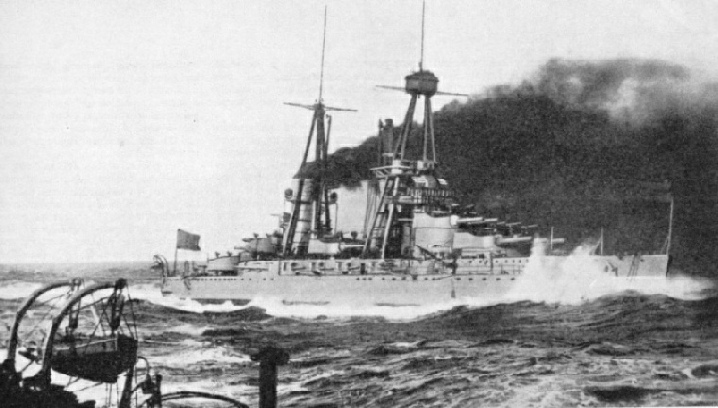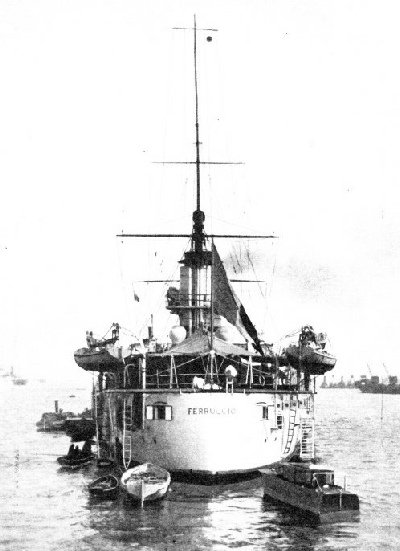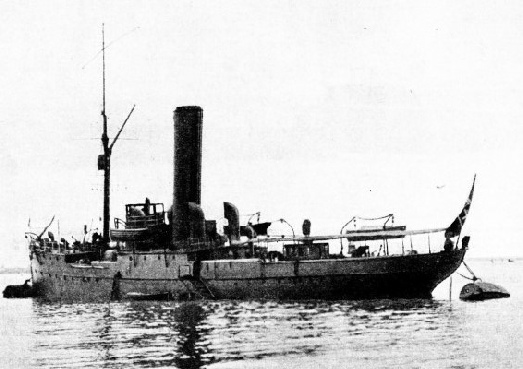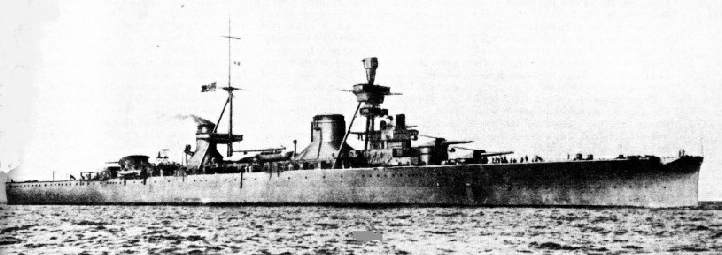During the war of 1914-18 the Italian Navy did not feature in any major action but distinguished itself by outstanding feats of a dashing nature. The present fleet has been built almost entirely since the war, and is one of the most powerful modern fleets in existence
FLEETS OF THE FOREIGN POWERS - 4

SPEED WAS INCREASED FROM 22 TO 27 KNOTS and horse-power from 31,000 to 75,000, when the Italian battleship Giulio Cesare (shown above) and her sister, the Conte di Cavour emerged from extensive reconstruction and modernization in 1936. Completed in 1914, the Giulio Cesare has an overall length of 577 ft. 6 in., a beam of 92 feet and a mean draught of 28 ft. 4 in. Her displacement tonnage is 25,000.
MARKED originality has always been shown by Italy in the design of her fighting ships. Nearly sixty years ago she startled the world by building two monster ships, the Italia and the Lepanto, which were undoubtedly the forerunners of the modern battle cruiser. They had the then unequalled displacement of nearly 14,000 tons, they were 400 feet in length, steamed at what was regarded as the extraordinary speed of 18 knots, and mounted the prodigious armament of four 100-tons guns. Some years later Italy also led the way in developing the fast and heavily-armed protected cruiser, and she did as much as any Power to improve the torpedo boat.
It is often claimed that the original dreadnought, or all-big-guns ship, was a purely Italian conception, for it is undeniable that several years before the Dreadnought herself was built Colonel Cuniberti, an Italian naval architect, published the plans and description of a proposed battleship which incorporated many of the outstanding features of the Dreadnought launched in 1906.
The battleship Dreadnought was, however, an entirely British production, representing the perfection of an idea which had been discussed between Lord Fisher and Sir Phillip Watts as far back as 1882, when Fisher was Captain of the old Inflexible and Watts a young and progressive naval architect. Over twenty years later, when both men had reached the top of their respective professions, they collaborated in producing a modern version of their “ship of dreams”. By building the first all-big-guns ship they effected a universal revolution in man-of-war design.
When Italy entered the war of 1914-18 in the spring of 1915 her navy was charged with the task of looking after the Austrian fleet in the Adriatic. The Italian sailors were denied the opportunity of fighting any major action, but in spite of this they performed some individual exploits of an exceedingly dashing and gallant nature. One of the most amazing feats of the whole war was the sinking in open sea of a great Austrian battleship, the Szent Istvan, by a tiny Italian motor boat under the command of Captain Rizzo, an officer of the naval reserve. Although the battleship had an escort of destroyers, Rizzo succeeded in getting through them and sending two torpedoes into the leviathan, which foundered some hours later with heavy loss of life.
Previously the same officer had navigated another motor boat into the fortified harbour of Pola, and there had torpedoed and sunk an older Austrian battleship, the Wien. Few individuals in the war of 1914-18 could claim the distinction of having disposed single-handed of two enemy capital ships. Another almost incredible achievement was the destruction of a third Austrian battleship, the Viribus Unitis, by a mobile mine which two Italian naval officers propelled on a raft into a fortified anchorage and attached with a time fuse to the hull of the doomed dreadnought.
Mainly through enemy sabotage and submarine activities the Italian Navy lost many ships, and the end of the war found it sadly deficient in modern material. Under the Washington Treaty of 1922 Italy was accorded full naval equality with France, though at that time this parity existed only on paper. One of the first acts of Signor Mussolini on becoming Dictator was to draw up a comprehensive programme for the rejuvenation and expansion of the navy. From that time down to the present day the Italian fleet has developed unceasingly, and equality with France is well on the way to becoming an accomplished fact.
The Italian fleet is essentially a postwar creation, consisting as it does in the main of up-to-date vessels and equipment. In 1936 two of the largest and most powerful battleships in the world were under construction, and two old battleships were being completely modernized in machinery and armament.
Seven heavy and twelve light cruisers had been built, the majority of which were appreciably faster than any foreign vessel. The destroyer flotilla had been increased to well over 100 units, and the submarine armada brought to a total of nearly eighty boats, which made it numerically second only to that of France in vessels of modern construction.
The regeneration of Italian sea power, however, has not been confined to shipbuilding. The system of entering and training officers and seamen has been drastically revised and, although discipline has been tightened up, its severity is tempered by many amenities, such as improved living quarters, better food, and more facilities for recreation, which previously did not exist. Some years ago a large proportion of the lower-deck personnel was illiterate, but nowadays the standard of education is much higher and the men therefore display more self-reliance and initiative.
The officers of the Italian Navy as a whole are studious, but in recent years increasing attention has been paid to the practical side of their profession by extending the period of exercises at sea and holding frequent manoeuvres. One example of the practical methods now in use may be cited. Every junior officer must undergo several months’ training in a destroyer flotilla. From time to time he is required to take full command of the flotilla, and put it through its paces at sea. This admirable system, which is believed to be peculiar to the Italian Navy, affords the best possible training for future command.
All the dockyards and bases used by the Italian fleet have been modernized and re-equipped with up-to-date plant. In the State yards and in private yards the building period for all types of ships has been reduced by about one-third, and it is claimed that Italy can now produce new tonnage, naval and mercantile, more expeditiously and cheaply than any other country in the world.
The main State dockyard is at Spezia, on the Gulf of Genoa. Next in importance is the naval establishment at Venice, and there are subsidiary bases at Naples, Taranto, Gaeta (north of Naples), and also in Sardinia and Sicily. More recently a well-equipped advance base has been created at Leros, one of the islands of the Dodecanese, in the Eastern Mediterranean. Apart from Leros, the most important overseas base is at Massawa, on the Red Sea, which has gained in strategic importance since the Italian occupation of Abyssinia in 1936.
The fleet is weak in capital ships but exceptionally strong in all other combatant types. Including two under construction, there are only six capital units. Those building, but not likely to be completed until 1938-39, are the battleships Littorio and Vittorio Veneto, which were laid down in October 1934. Displacing 35,000 tons, they were the largest battleships under construction in the world in 1936, and other official details which have been released leave no doubt as to the extraordinary power of these capital ships.

AN EARLY ARMOURED CRUISER of 6,299 tons displacement, the Francesco Ferruccio was completed in 1905. Reciprocating engines of 13,635 horse-power give her a speed of 19 knots. She is armed with one 10-in., two 8-in., four 6-in. and eight 3-in. Guns. Cruisers of this type are fast being replaced with more modern vessels.
The machinery is designed for 125,000 horse-power, which it is calculated will give a speed of at least 30 knots, or little inferior to that of the fastest battle cruisers afloat. The ships are to have massive protection against gunfire and air bombs, and either vessel is to be armed with nine 15-in. guns in triple turrets, twelve 6-in. guns, twelve 3½-in. anti-aircraft pieces and twenty machine guns. Other equipment is to include four seaplanes. As either vessel is estimated to cost £7,000,000, it is clear not only that Italy is prepared to make great sacrifices for the sake of her fleet, but also that her naval experts are satisfied that monster battleships are still essential.
There are four pre-war battleships — Giulio Cesare, Conte di Cavour, Caio Duilio and Andrea Doria — laid down in 1910-12, with an average displacement of about 21,800 tons, a speed of 21 to 22 knots, and an original main armament of thirteen 12-in. guns. The first pair, the Giulio Cesare and the Conte di Cavour, emerged in 1936 from a process of reconstruction which completely changed their characteristics.
Fitted with an entirely new propelling plant, their horse-power was increased from 31,000 to 75,000, giving a speed of 27 knots. In place of the original armament they now carry ten 12.6-in. guns of a new pattern, as well as twenty anti-aircraft pieces and the same number of machine guns. Their protection against every form of attack has been greatly strengthened, and for all practical purposes they are new ships.
Eventually, therefore, Italy will have four fast and powerful capital ships which will constitute the backbone of her fleet. Moreover, similar reconstruction of the Caio Duilio and the Andrea Doria is contemplated.
Italy has already completed seven heavy cruisers of the 10,000-tons class, armed with eight 8-in. guns. Three of these, Trento, Trieste and Bolzano, are only lightly protected, but have the unusually high speed of 35 knots. In the other four 10,000-tons ships protection has been strengthened by cutting the speed down to 32 knots. These latter vessels, the Fiume, Zara, Pola and Gorizia, are undoubtedly superior in defensive power to the British “County” class cruisers of the same tonnage, which are of earlier design.
World’s Fastest Cruisers
Probably the most interesting ships in the Italian Navy are the light cruisers of the so-called “Condottieri” type, built between 1928 and 1935. The earlier ships of this remarkable group displace only 5,069 tons, yet they carry an armament of eight 6-in. guns, equal to that of the British 7,140-tons Leander, and at the same time are by a considerable margin the fastest cruisers in existence.
The designed speed of 37 knots has been exceeded in every instance. One ship, the Alberico da Barbiano, attained a maximum of 42 knots on her trials and subsequently ran for eight hours at an average speed of 39¾ knots.
These small cruisers are therefore veritable “wonder ships”, and their tremendous speed has not been obtained at the cost of strength or seaworthiness. In the later ships of the same group the displacement has been increased to 5,857 and 6,791 tons and the armament is said to comprise ten 6-in. guns. Besides the nineteen heavy and light cruisers of modern design there are seven older cruisers, the majority of which formerly belonged to Germany or Austria and no longer have much fighting value.
The Italian destroyer force is largely of modern construction, nearly seventy units having been built since 1922. It is headed by a group of twelve flotilla leaders named after famous Italian navigators. These vessels have a displacement of 1,628 tons, a designed speed of 38 knots and an armament of six 4.7-in. guns, four anti-aircraft guns and six torpedo tubes, as well as a supply of mines.
These fine vessels have proved exceedingly fast in service, one of them, the Alvise da Mosto, being credited with a speed of 45 knots. The average Italian destroyer of modern design is a one-funnelled vessel of 1,449 tons, with a speed of 38 knots and an armament of four 4.7-in. guns and six torpedo tubes. In addition to destroyers proper, Italy has developed a smaller edition of the type, with a displacement of only 615 tons. These boats, however, can steam at 34 knots and they carry a good armament. Six had been built by 1936, and there is reason to believe that the type will be multiplied in the near future.

DESIGNED FOR DEEP DIVING the submarine Antonio Sciesa is of the same class as the Domenico Millefire, which, it is claimed, broke the world’s record for deep diving when she reached a depth of 66 fathoms (396 feet) in 1928. Of 1,363 tons surface displacement, the Antonio Sciesa was completed in 1929 and has a surface speed of more than 17 knots. Her submerged speed is 9J knots. She has an overall length of 282 feet, a beam of 24 ft. 6 in. and a mean draught of 14 feet
Probably because of the dramatic successes achieved by her small torpedo launches during the war of 1914-18 Italy still retains a flotilla of these mosquito craft, of which many are boats of 15 tons with a speed of 40 knots, armed with two torpedoes. In spite of sensational reports of the power of these tiny vessels, there is no reason to suppose them superior in any way to the motor torpedo-boats which are being added to the British Navy. On the contrary, the British vessels are understood to have definite superiority in speed, seaworthiness, and radius of action.
No branch of the Italian Navy has undergone more rapid development than the submarine service. Between 1926 and 1936 nearly seventy new boats were built, ranging from ocean-going vessels of 1,371 tons to coastal minelayers of 599 tons. Italian submarine construction follows original lines, the guiding principles of which are strength, safety, and handiness of manoeuvring below water. The world’s record for deep diving is claimed on behalf of the Italian boat Domenico Millelire (1,368 tons), which some years ago reached a depth of 66 fathoms (396 feet) without discomfort to her crew. More recently two other Italian submarines circumnavigated Africa and travelled 15,000 miles in under six months without developing the slightest defect.
Italian submarines are well up to the international standard of efficiency and second to none in excellence of design and construction. It was unofficially reported in 1936 that the Italian Government aimed to raise the submarine establishment to a strength of 100 first-line boats. To reach this figure it was then necessary to build only thirty-four new units, and no fewer than twenty-two submarines were laid down in a single year. Although, as in the British Navy, the submarine service is officered and manned by specialists, every Italian naval officer is required to do a tour of duty in submarines as part of his general training.
Since the Italian Navy is intended primarily to operate in the Mediterranean, where distances are comparatively short, it does not feel the need for large aircraft carriers so acutely as do oceanic fleets such as the British and American. The only Italian carrier is the Miraglia, a converted merchantman of 4,960 tons, with a speed of 21½ knots, equipped with twenty planes and catapults fore and aft for launching purposes.
Aircraft Co-operation
On the other hand, Italy has developed to a high degree the tactical co-operation of warships and aircraft, and in particular has gained a long lead over all competitors in the evolution of the flying boat for naval work. Every Italian naval base has a large contingent of aircraft detailed for co-operation with the local naval forces. It is considered more than probable that Italy would be able to effect an overwhelming concentration of air power, not only in the vicinity of her own coast-line but even at almost any point in the Eastern Mediterranean.
In 1936 the personnel of the navy numbered about 3,000 officers and 50,000 men. The men included a fair proportion of long-service volunteers, but the lower-deck was still largely recruited on the conscript system. When recruits are entered for the naval service preference is given to men from Northern Italy and particularly from the Genoa district, among the population of which sea service is traditional. Italian naval officers do not conceal the fact that petty officers and ratings from the Genoese and Venetian coasts constitute the backbone of the lower-deck personnel, and it is an abiding source of complaint that these regions cannot supply more than a part of the man-power required for the navy.
New recruits receive their preliminary training in shore establishments, of which the naval school at Trieste is a recent example. In this large and well-equipped establishment the new entries are taught the rudiments of seamanship, signalling, gunnery and the like, and are familiarized with the discipline and routine of their new service. Special attention is paid to physical training, which is conducted on the most scientific principles.
The fact that Italy alone among the great Powers has no direct access to the ocean is constantly being stressed by her statesmen and publicists. To reach the Atlantic and the New World her ships must pass through the Straits of Gibraltar, and her only outlet to the Pacific and the Far East is through the Suez Canal. She cherishes the ambition, therefore, to become mistress of what she regards and calls her “own” sea, the Mediterranean. That she will attain complete supremacy over the entire Middle Sea is extremely doubtful, having regard to the fact that other Powers have vital interests there. Italy, however, holds a key position which a strong navy operating in
conjunction with a powerful air force would enable her to exploit to the utmost in certain eventualities.

ONE OF THE ITALIAN HIGH SEA TUGS (known officially as Rimorchiatori d'Alto Mare), the Ciclope is a twin-screw vessel of 640 tons, built in 1903 at Naples. She is armed with two 3-in. guns and her 1,900 horse-power engines give her a speed of nearly 14 knots.
Midway on the main traffic route through the Mediterranean, which must be traversed by all ships operating between Gibraltar and Suez, there is a comparatively narrow defile or bottleneck formed by Sicily on the north-east and by Cape Bon, on the African coast, to the south-west. Any Power which was able to establish strategic command over this defile would be in a position to control, and if need be bring to a standstill all traffic on the main Mediterranean highway.
On paper it may seem that such command could be established without much difficulty, given the requisite degree of naval and air power. In practice, however, it might prove difficult to the point of impossibility, for British experience in 1914-18 demonstrated the extreme difficulty of maintaining an effective watch over the Dover Strait, which is only one-quarter the width of the passage between Sicily and Africa.
All these problems have doubtless been taken into consideration by those responsible for Italian naval policy. Moreover, Italy does not necessarily assume that in any future conflict she would be left to fight single-handed. She feels, indeed, that the stronger her fleet becomes the more attractive she will prove as the ally of some oceanic Power, in which event the strategic potency of her own fleet would be multiplied indefinitely. It is necessary to take note of these considerations to understand the motives which recently have impelled Italy to make such tremendous sacrifices for the rebuilding of her navy. Under the existing system of administration Signor Mussolini is Minister of Marine, though he delegates most of his executive powers to his deputy, Admiral Cavagnari.
The Italian Admiralty, housed in a new and stately building on the banks of the River Tiber, is organized on much the same plan as the British, with separate divisions for intelligence, planning, operations, naval construction, engineering and armament. The staff is comparatively large, and includes admirals on the active and on the retired list. High naval rank is occasionally bestowed on distinguished civilians as a special mark of favour, among such recipients being the celebrated radio expert, Signor Marconi, who was appointed a rear-admiral.
In contrast to certain other admiralties, whose attitude to all innovation is decidedly conservative, the Italian naval authorities eagerly take up and exploit every promising technical idea that is submitted to them. This probably accounts for certain novel items of equipment, the value of which is self-evident. For example, the gun turrets of all the modern cruisers are fitted with anti-flash and other safety devices which appear to be in advance of similar fittings in non-Italian warships.
Another instance of the progressive spirit animating the Italian service is provided by the experiments that are continually being conducted to improve the efficiency of existing weapons and to evolve new methods of using them.
Thus in the early months of 1936 it became known that the Italian Navy had tried out a system of dropping torpedoes from the air by parachutes.
In attempting to assess the combatant power of any armed force we are confronted with one imponderable and incalculable factor — the quality and spirit of the personnel. Only the test of combat itself can settle that particular point, but there is no reason to doubt that the sailors of modern Italy are worthy of the fine ships in which they serve.
In the material sense the present-day Italian Navy will stand comparison with any other, for no observant visitor can fail to be impressed by the careful design and high-class workmanship which distinguish every vessel of the new fleet and every item of equipment.

AN UNUSUALLY HIGH SPEED of 35 knots is attained by the Italian cruiser Trento. Completed in 1929, she has a displacement of 10,000 tons and is armed with eight 8-in. guns, sixteen 3.9-in. anti-aircraft and eight smaller guns, in addition to eight torpedo tubes. The Trento has an overall length of 642 feet, a beam of 67 ft. 6 in. and a mean draught of 19 feet.
You can read more on “Italian Shipping”, “The Rex and the Conte de Savoia” and “Undersea Weapons” on this website.







